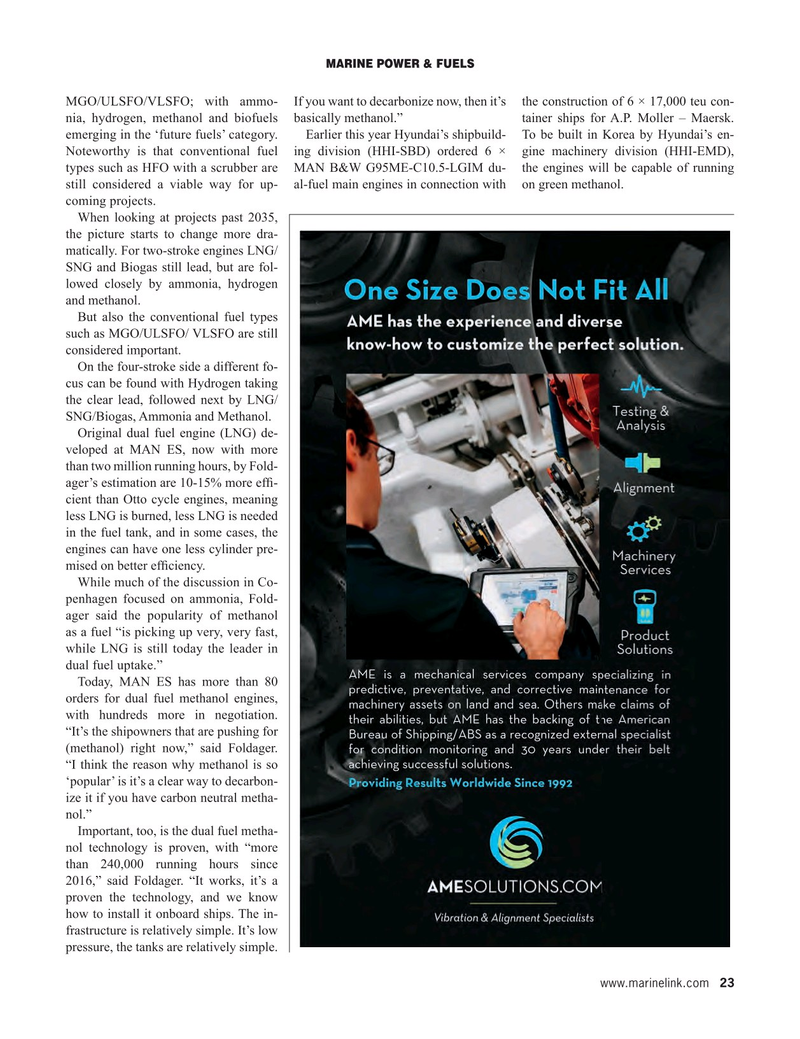
Page 23: of Maritime Reporter Magazine (January 2023)
The Ship Repair & Conversion Edition
Read this page in Pdf, Flash or Html5 edition of January 2023 Maritime Reporter Magazine
MARINE POWER & FUELS
MGO/ULSFO/VLSFO; with ammo- If you want to decarbonize now, then it’s the construction of 6 × 17,000 teu con- nia, hydrogen, methanol and biofuels basically methanol.” tainer ships for A.P. Moller – Maersk. emerging in the ‘future fuels’ category. Earlier this year Hyundai’s shipbuild- To be built in Korea by Hyundai’s en-
Noteworthy is that conventional fuel ing division (HHI-SBD) ordered 6 × gine machinery division (HHI-EMD), types such as HFO with a scrubber are MAN B&W G95ME-C10.5-LGIM du- the engines will be capable of running still considered a viable way for up- al-fuel main engines in connection with on green methanol.
coming projects.
When looking at projects past 2035, the picture starts to change more dra- matically. For two-stroke engines LNG/
SNG and Biogas still lead, but are fol- lowed closely by ammonia, hydrogen and methanol.
But also the conventional fuel types such as MGO/ULSFO/ VLSFO are still considered important.
On the four-stroke side a different fo- cus can be found with Hydrogen taking the clear lead, followed next by LNG/
SNG/Biogas, Ammonia and Methanol.
Original dual fuel engine (LNG) de- veloped at MAN ES, now with more than two million running hours, by Fold- ager’s estimation are 10-15% more ef? - cient than Otto cycle engines, meaning less LNG is burned, less LNG is needed in the fuel tank, and in some cases, the engines can have one less cylinder pre- mised on better ef? ciency.
While much of the discussion in Co- penhagen focused on ammonia, Fold- ager said the popularity of methanol as a fuel “is picking up very, very fast, while LNG is still today the leader in dual fuel uptake.”
Today, MAN ES has more than 80 orders for dual fuel methanol engines, with hundreds more in negotiation. “It’s the shipowners that are pushing for (methanol) right now,” said Foldager. “I think the reason why methanol is so ‘popular’ is it’s a clear way to decarbon- ize it if you have carbon neutral metha- nol.”
Important, too, is the dual fuel metha- nol technology is proven, with “more than 240,000 running hours since 2016,” said Foldager. “It works, it’s a proven the technology, and we know how to install it onboard ships. The in- frastructure is relatively simple. It’s low pressure, the tanks are relatively simple. www.marinelink.com 23
MR #1 (18-33).indd 23 1/9/2023 7:06:14 AM

 22
22

 24
24
